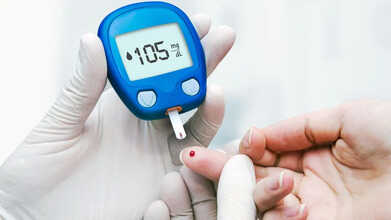- Health Conditions A-Z
- Health & Wellness
- Nutrition
- Fitness
- Health News
- Ayurveda
- Videos
- Medicine A-Z
- Parenting
Ways You Can Beat The Midday Slump

(Credit-Canva)
Feeling sleepy after eating a big meal or after an early morning is normal. While excessive sleepiness does raise alarm, the key to avoid it to understand what is triggering it.
Our bodies have an internal clock, called the circadian rhythm, that controls when we feel sleepy or awake. According to National Institute of General Medical Sciences (NIGMS), these rhythms include physical and mental changes an organism experiences over 24-hour cycle.
According to John Hopkins Medicine this clock makes us naturally feel a bit sleepy in the early afternoon, usually around 1:00 or 3:00 PM. It's like a built-in dip in our energy levels. Scientists have studied this, and they've found that we're usually most alert in the morning and early evening, with a little dip in between. In some countries, people used to take a short nap in the afternoon to deal with this. It's just a normal part of how our bodies work, but we can learn how to manage it.
Ways You Can Avoid The Afternoon Crash
Everyone gets sleepy in the afternoon sometimes. It's a normal part of life. But you don't have to let it ruin your day. Sometimes, feeling really sleepy during the day can be a sign of a medical problem. If you have a condition like sleep apnea or narcolepsy, or if you take medicine that makes you sleepy, you might feel extra tired in the afternoon. The natural dip in alertness makes it even worse for you. If you're feeling excessively sleepy during the day, it's important to talk to your doctor. They can help you figure out what's going on and find ways to feel more awake and alert. By taking care of your sleep habits, you can make it easier to get through the day without feeling tired all the time. Here are some ways you can avoid the afternoon crash.
Prioritize Sleep
Quality sleep is crucial. Aim for consistent bedtime routines and sufficient hours of rest. Sleep deprivation amplifies afternoon fatigue. A well-rested body manages energy dips more effectively, reducing the severity of the midday slump.
Increase Physical Activity
Even brief movement combats sleepiness. Stand up, stretch, or take a short walk. Physical activity boosts blood flow and oxygen to the brain, enhancing alertness. Regular, light activity throughout the day helps maintain energy levels.
Lighter Lunch Choices
Heavy, carb-loaded lunches divert energy to digestion, inducing sleepiness. Opt for balanced meals with lean protein and vegetables. Lighter meals prevent excessive energy shifts, helping you stay alert and focused in the afternoon.
Caffeine or Hydration
Moderate caffeine intake can temporarily increase alertness. However, avoid excessive amounts, especially later in the day. Hydration is vital; water improves circulation and cognitive function. Choose refreshing drinks to stay hydrated and energized.
Vitamin C Supplementation
Vitamin C's antioxidant properties may reduce fatigue. It combats oxidative stress, a contributor to tiredness. Consider a supplement or vitamin C-rich foods. Remember, individual responses vary, and it's best to consult a healthcare professional.
Shift Mental Focus
When feeling sleepy, change your mental environment. Focus on completed tasks or engage in enjoyable activities. Distraction can redirect your mind, temporarily alleviating the feeling of sleepiness. A brief mental break can provide a needed reset.
Power Naps
Short naps (20-30 minutes) can rejuvenate, but avoid longer naps. They can lead to grogginess. Napping too close to bedtime disrupts nighttime sleep. A brief nap during the early afternoon can restore alertness and improve productivity.
Can A Weekly Serving Of Yogurt Lower Your Type 2 Diabetes Risk? Expert Explains

Credits: Canva
A recent paper in The Journal of Nutrition reports that there is promising, although still developing, scientific evidence linking regular yogurt intake with a lower chance of developing type 2 diabetes (T2D). These findings supported the Food and Drug Administration’s 2024 decision to permit a qualified health claim for yogurt.
The agency stated that steady yogurt consumption appears to be tied to reduced T2D risk and that the new claim can help guide public messaging to encourage people to eat more yogurt, which also raises intake of nutrients many people lack, such as calcium. To understand this connection more clearly, we spoke with Prof. (Dr.) Supriya Awasthi, Dean and Professor at the School of Allied Health Sciences, Noida International University.
What Is Type 2 Diabetes?
Type 2 diabetes is a long-term condition in which the body does not make enough insulin or does not respond to it properly. This leads to high blood sugar levels that gradually damage nerves, blood vessels, and several organs. It is the most widespread form of diabetes. According to the Mayo Clinic, it can often be delayed or prevented by staying active and maintaining a healthy weight.
Yogurt, a simple and widely consumed dairy food, has attracted attention for its possible protective effect. Fermented foods like yogurt contain helpful bacteria known as probiotics. These bacteria support gut health. Research on the gut is still progressing, but scientists now believe the balance of gut bacteria may affect many health concerns, including obesity and diabetes.
Since type 2 diabetes is one of the most common lifestyle-related disorders worldwide, experts continue to study how daily food choices shape its risk. But can a weekly serving of yogurt truly matter? Dr Supriya said that it can, especially when yogurt is part of an overall balanced eating pattern.
Yogurt And Diabetes Type 2
Yogurt offers probiotics that help keep the gut microbiome in good condition. A healthy gut environment supports better metabolism, lowers inflammation, and improves how the body handles glucose. Ongoing inflammation and poor gut balance are well-known contributors to insulin resistance, which is the driving factor behind type 2 diabetes. According to Dr Supriya, regular yogurt intake may ease these problems and help the body manage blood sugar more effectively.
She also explained that yogurt’s protein content and naturally low glycemic index offer added advantages. She said, “Protein keeps you satisfied longer and helps curb sudden cravings. Foods with a low glycemic index do not raise blood sugar quickly. This can help prevent spikes in insulin and reduce the chances of developing insulin resistance over time.”
Several studies show that people who include plain or low-fat yogurt in their weekly meals tend to manage their weight better, which is an important part of lowering diabetes risk.
Is Yogurt Bad For Diabetic Patients?
Yogurt is not harmful for people with diabetes, but choosing the right kind is essential. Many flavored or sweetened yogurts contain large amounts of added sugar, which can raise the risk of diabetes complications. The best choices are plain, unsweetened, low-fat, or Greek yogurt. These provide strong nutritional value without unnecessary sugar. Adding fruits, nuts, or seeds can improve taste in a healthy way.
Dr Supriya said, “While yogurt can support better metabolic health, it should not be viewed as a cure on its own. Its benefits are strongest when combined with a healthy routine that includes regular physical activity, weight control, fiber-rich meals, and limited sweets.” Even so, having yogurt two to four times a week may help maintain steadier blood sugar and lower long-term risk for type 2 diabetes.
Eating yogurt each week can be a simple and useful step in a diabetes-prevention plan. Its probiotics, protein, and gentle effect on blood sugar make it a valuable food for metabolic wellbeing. By choosing plain, low-sugar varieties and pairing them with healthy lifestyle habits, people can take a small but meaningful step toward lowering their chances of developing type 2 diabetes.
World Diabetes Day 2025: How Monthly Hormone Changes Affect Blood Sugar, Expert Weighs In

Credits: Canva
World Diabetes Day is observed on November 14 each year to raise awareness about diabetes, its prevention, and its management. The day aims to support individuals living with diabetes and encourage collective actions to reduce the overall burden of the disease. According to the World Health Organisation, the number of people living with diabetes increased from 200 million in 1990 to 830 million in 2022.
India is often referred to as the diabetes capital of the world due to its high number of people diagnosed with the condition. One interesting aspect about blood sugars, especially in women, is that they continue to shift through the month because of hormonal activity.
To understand this pattern better, we spoke with Dr Monika Sharma, Senior Consultant, Endocrinology, Aakash Healthcare who explained the link.
Can Hormones Affect Blood Sugar Levels Throughout a Woman’s Cycle?
As per the Ministry of Health and Family Welfare, hormones do play a strong role in shaping blood sugar levels. Some, such as insulin and glucagon, work directly on glucose regulation, while others, including stress hormones, estrogen, progesterone and aldosterone, influence how the body responds to insulin and how steady blood sugar remains. Hormonal swings at different stages of life such as menstruation or menopause can push blood sugar higher or lower.
Estrogen And Progesterone Affect Insulin Sensitivity During Menstrual Cycle
Estrogen and progesterone rise and fall throughout a woman’s monthly cycle and these shifts can change how the body reacts to insulin. When estrogen is higher and progesterone is lower in the follicular phase, the body tends to handle glucose better and stays more insulin sensitive.
Dr Monika said, “The opposite applies in the luteal phase, where progesterone levels go up and this may cause insulin partialization and even mild blood sugar increases, sugar cravings or fatigue prior to menstruation.”
Menopause Can Change The Way The Body Handles Insulin
Menopause alters the body’s natural glucose regulation because estrogen levels drop. With less estrogen the body becomes less sensitive to insulin and fat may gather around the abdomen which makes it harder to keep blood sugar within a normal range.
“Consequently, women in or after menopause are more vulnerable to the development of insulin resistance as well as type 2 diabetes despite the fact that their blood sugar levels had been maintained to normal levels previously,” as per Dr Monika.
Warning Signs That Suggest Hormonal Imbalance Is Worsening Glucose Control
There are several small but meaningful signs to watch for. These may include sudden weight gain around the stomach area constant desire for sweets ongoing tiredness changes in mood poor sleep or irregular periods. Hormonal shifts can cause unpredictable sugar levels in women with diabetes or prediabetes. It is important to keep track of these changes and reach out to a doctor early because adjustments in lifestyle or medicines can help prevent worsening of glucose control.
Building Daily Habits to Beat Cardiovascular Risk

Credits: Canva
When it comes to heart health, the truth is simple yet powerful: it’s never too early or too late to start caring for your heart. In today’s fast-paced world, our heart faces relentless challenges, from stress and sedentary lifestyles to poor eating habits. But good news small, consistent habits can pack a powerful punch in beating cardiovascular risk, no matter your age.
Understanding the ticking heart
The heart is both resilient and vulnerable. It beats tirelessly day and night, powering our life’s journey. But factors like high blood pressure, cholesterol, smoking, and diabetes can silently damage it over time, making heart disease the leading cause of death globally. What’s even more sobering is how early these risks can start, sometimes as early as in our 20s and 30s.
Building habits that last
The best way to protect the heart is by weaving heart-friendly habits into daily life from young adulthood through old age.
Here’s what works:
Move more, sit less: Physical activity is a cornerstone. Whether it’s a morning walk, yoga, or even dancing to your favorite tune, moving your body keeps the heart muscle strong and improves blood circulation. Finding joy in movement is key to consistency.
Eat with purpose: Whole foods, fresh fruits, vegetables, nuts, and lean proteins nourish the heart. Limit processed foods, excess salt, and sugary treats. Remember, it’s not about strict diets but about embracing a lifestyle that honors your body.
Manage stress mindfully: Chronic stress spikes heart rate and blood pressure. Practices like meditation, deep breathing, or simply spending time with loved ones help you stay calm and connected.
Prioritize sleep: Quality sleep regenerates the heart and balances hormones. Aim for 7-8 hours each night to support your cardiovascular system.
Regular check-ups: Awareness is power. Keep track of blood pressure, cholesterol, and blood sugar, and consult a healthcare professional regularly.
Heart health isn’t reserved for those with symptoms. It’s a lifelong journey of love and care towards your most vital organ. As someone who has spent years helping people transform their fitness and wellness journeys, I urge you to start small but think big. Your heart will thank you every beat of the way.
Remember, it’s not just about adding years to life, but life to years. Build these habits today for yourself, your family, and generations to come.
Stay strong, stay heart-healthy.
© 2024 Bennett, Coleman & Company Limited

